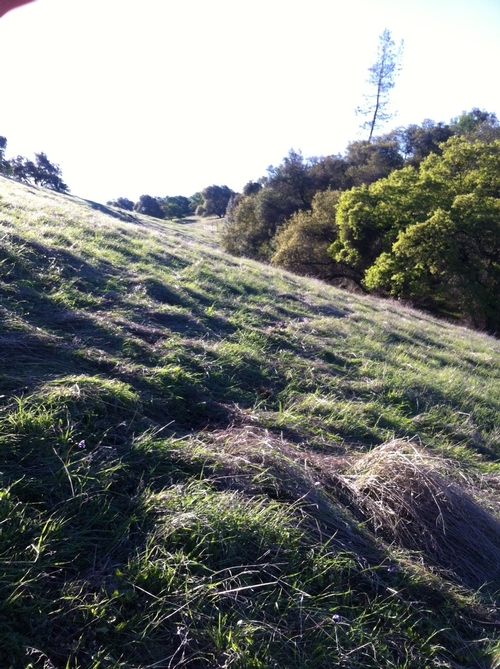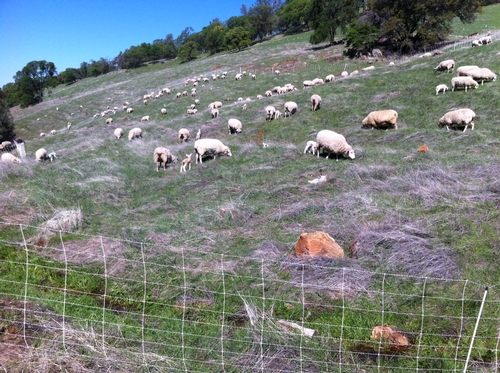
Last week, I received an update from the Sierra Foothill Research and Extension Center (SFREC) in Browns Valley, California, regarding estimated forage (grass) production. As you may recall, the January 1 measurement at SFREC was just 52 pounds per acre of forage – about 10 percent of normal for that date. The big storm we experienced in early February (over 7 inches of rain in four days) helped tremendously, as did the smaller storms that came through in late February. As of March 3, SFREC measured 400 pounds of forage per acre (about 58 percent of normal). Based on data collected at SFREC since 1979-80, we now have as much forage as we would expect to see by December 1 in a normal winter – in other words, we are 3 months behind schedule when it comes to growing grass.
My experience with grazing our sheep near Hidden Falls Regional Park northwest of Auburn confirms this lack of production. Our ewes are currently giving birth – which means they are consuming nearly twice as much forage as they do when they are not pregnant or producing milk for lambs. We typically time our lambing season to coincide with the onset of rapid grass growth – we try to match our period of highest demand with the supply of highly nutritious and rapidly growing forage. Last fall when we turned our rams in with the ewes (ewes are pregnant for about 150 days), we expected normal weather and forage production. This spring, we're adjusting to much drier conditions. Since we currently have about as much green grass as we'd expect to see in December, this means that we're moving sheep much more frequently. Yesterday, I built a 3+ acre paddock using portable electric fencing. Normally, this much grass would last our ewes 3-4 days at this time of year. This year, we were able to keep the sheep in this paddock for about 36 hours. The drought means we are spending twice as much time moving sheep as we normally would in March. It also means that our pasture recovery periods (the time in which we let graze pastures rest before grazing again) are longer - 35-40 days rather than the 25-30 days we'd normally expect in mid-March.
Because of the short grass this spring, I'm growing increasingly worried about conditions next autumn. Our foothill rangelands are dominated by annual grass and forb (broadleaf) species. By definition, an annual plant must complete its lifecycle in one year – that is, it must germinate, grow, reproduce and die all within one growing season. In drier years, annual plants will often mature and reproduce earlier – and at a lower height – in order to ensure that they create seeds for the next growing season. I anticipate that we'll see our rangeland plants mature earlier this year – I'm already seeing foxtail barley and wild oats “heading out” (setting seeds) in early March – a good month earlier than normal.
So why am I worried about conditions next fall? In a "normal" year, we try to abide by the principle of "take half, leave half" on our unirrigated rangelands. This means that we try to leave at least 800 pounds of standing grass (the technical term is “residual dry matter”) at the end of the growing season (which usually happens in May). We leave this much "residual dry matter" for several reasons:
- It provides a micro-environment that encourages earlier germination once the fall rains commence by moderating temperature, retaining moisture and protecting new grass seedlings.
- It protects our soils by providing root structure and intercepting the energy of falling rain drops - in other words, it prevents erosion.
- It helps give more desirable plants a leg up on invasive weeds (generally). Invasive weeds tend to like disturbed or bare soils. Too much residual can also encourage invasives to take over a site, so we try to find a balance.
- Finally, saving this much dry grass gives us a stockpile of dry forage going into the fall months. Dry grasses are not terribly nutritious for our livestock (we generally need to provide some supplemental nutrition), but we time our production system to be able to graze our ewes on this dry feed when they have lower nutritional demands (that is, when they are not about to give birth or lactating).
Based on past experience, we may be lucky to grow 800-1000 pounds of grass on some of our rangelands this year, so taking half would leave us under this threshold going into next fall. If we graze too much this spring, we create the potential for erosion and weed infestation next year - and we'd have little or no fall feed for our ewes.
Many beef cattle producers in the foothills breed their cattle to deliver calves in the fall. This may seem counter-intuitive based on the above discussion (after all, these cows experience their greatest nutritional demand at a time when the quality of forage is at its low point for the year). However, many ranchers feel that they can take better advantage of the spring flush of forage growth if their calves are mature enough to gain weight from grazed forage. Fall calving operations have limited options for dealing with shortages of fall forage – they can purchase hay, lease additional grazing land, and/or sell cows.
As a sheep producer, I have more flexibility. This winter and spring we're grazing on land that has not been grazed for two years, which allows us to save our summer and fall grazing land. While we may graze the land we're currently grazing again next winter and spring, we're not relying on it for forage this coming fall. Consequently, we can make sure we leave enough residual dry matter to provide the benefits outlined above. We'll also continue to look for options to graze additional rangeland through the summer and fall months. Because our entire system (animals, fencing, livestock water, etc.) is portable we can move our animals to where the feed is (rather than buying additional feed and bringing it to the animals).
On Monday, March 24, UCCE Livestock and Natural Resources Advisor Roger Ingram is organizing a workshop in Auburn for livestock producers to help us work through these questions on our own operations. We'll get some hands-on experience in estimating forage supply and thinking through our fall forage scenario. Roger will also provide information regarding animal health and nutrition, and early weaning strategies. For more information, go to http://ucanr.edu/sites/placernevadasmallfarms/?calitem=234305&g=22527.
Drought planning, as I've written previously, is most effective if it's done while it's raining! While we've chosen to raise sheep for a number of reasons, the flexibility that sheep (and other small ruminants, like goats) provide for harvesting forage seems like a good decision during the current drought. We'll see what next fall brings us!